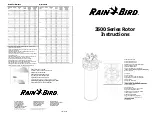
Page 7
3.5 WATER BALANCE AND CHEMISTRY RECOMMENDATIONS
Water balance is not complicated. It is the relationship between different chemical measurements in
your pool water. A pool that is balanced has proper levels of pH, Total Alkalinity and Calcium Hardness.
Balanced water can also be defined as water that is not corrosive or scaling. Water that is not balanced
can damage equipment and pool surfaces.
Proper water chemistry levels are essential to maintain safe and consistent swimming pool operation.
Sanitizers are used to destroy harmful or otherwise objectionable organisms. Stabilizer is used to
prevent unnecessary loss of chlorine to sunlight. Salt is used by the Digital Nano/Nano+ to generate
chlorine sanitizer.
Please note the following recommended water chemistry parameters are for residential pool/spa
applications only. Follow local regulatory guidelines for any commercial pool applications.
POOL
SPA
PARAMETER
UNITS
MIN
IDEAL
MAX
MIN
IDEAL
MAX
Free Chlorine
ppm (mg/L)
1.0
2.0 - 4.0
5
2.0
3.0 - 4.0
10
Combined Chlorine
ppm (mg/L)
0.0
0.0
0.2
0.0
0.0
0.5
pH
ppm (mg/L)
7.2
7.2 -7.8
7.8
7.2
7.2 -7.8
7.8
Total Alkalinity
ppm (mg/L)
60
80 - 100
180
60
80 - 100
180
Calcium Hardness
ppm (mg/L)
150
200 - 400
1000
100
150 - 250
1000
Salt
ppm (mg/L)
2000
2500 - 4500
**
2000
2500 - 4500
**
Cyanuric Acid (stabilizer) ppm (mg/L)
0
30 - 50
***
0
30 - 50
***
Table 1
** Typically 6000 ppm (mg/L) or less is recommended; unit can operate with levels as high as
35,000+ ppm (mg/L).
*** This is dictated by state or local codes but is typically 100 ppm (mg/L).
See “Basic Water Chemistry” in section 10.1 on page 48, and “Using the Saturation Index” in section
10.2 on page 51 for further information concerning pool/spa water chemistry maintenance
requirements. Refer to the Troubleshooting section on page 42 in the back of this manual for
assistance with resolving low or high chlorine levels.














































